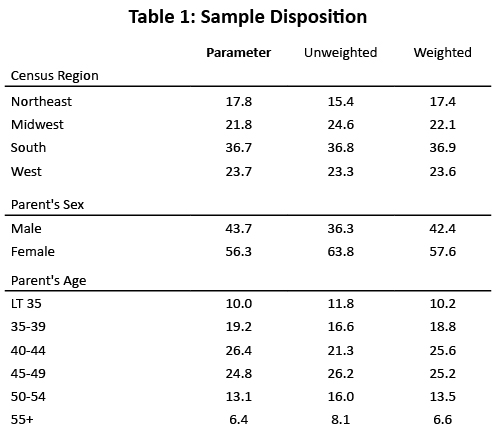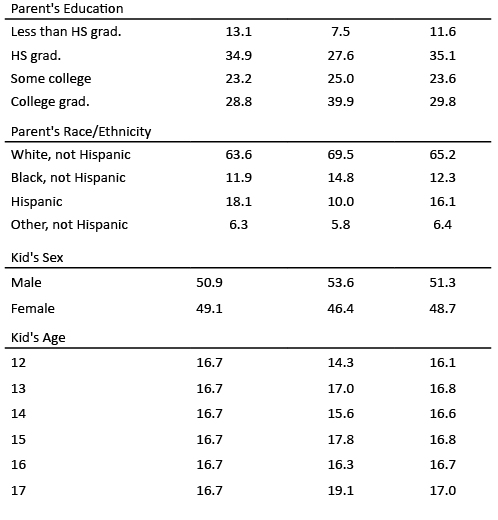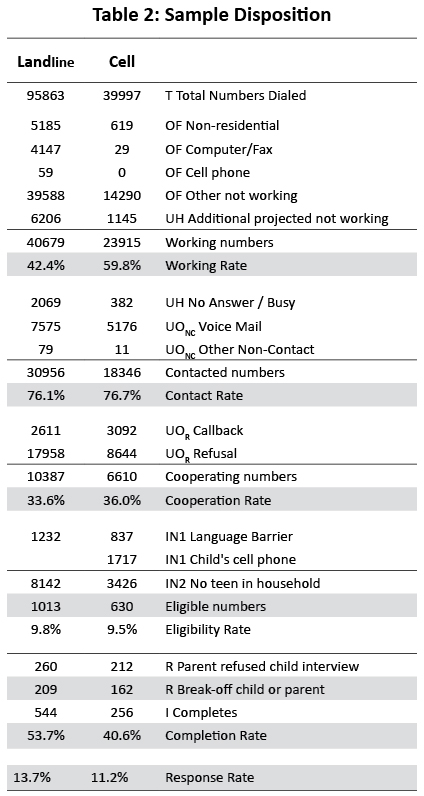Methodology
This report is based on the findings of a telephone survey on teens’ and parents’ use of mobile phones and 6 focus groups conducted in 3 U.S. cities in October 2009 with teens between the ages of 12 and 18. The quantitative results in this report are based on data from telephone interviews conducted by Princeton Survey Research International between June 26 and September 24, 2009, among a sample of 800 teens ages 12-17 and a parent or guardian. For results based on the total sample, one can say with 95% confidence that the error attributable to sampling and other random effects is plus or minus 3.8 percentage points for the complete set of weighted data. In addition to sampling error, question wording and practical difficulties in conducting telephone surveys may introduce some error or bias into the findings of opinion polls.
A combination of landline and cellular random digit dial (RDD) samples was used to represent all teens and their parents in the continental United States who have access to either a landline or cellular telephone. Both samples were provided by Survey Sampling International, LLC (SSI) according to PSRAI specifications.
Numbers for the landline sample were selected with probabilities in proportion to their share of listed telephone households from active blocks (area code + exchange + two-digit block number) that contained three or more residential directory listings. The cellular sample was not list-assisted, but was drawn through a systematic sampling from dedicated wireless 100-blocks and shared service 100-blocks with no directory-listed landline numbers.
Interviews were conducted from June 26 to September 24, 2009. As many as 7 attempts were made to contact and interview a parent at every sampled telephone number. After the parent interview, an additional 7 calls were made to interview an eligible teen. Sample was released for interviewing in replicates, which are representative subsamples of the larger sample. Using replicates to control the release of sample ensures that complete call procedures are followed for the entire sample. Calls were staggered over times of day and days of the week to maximize the chance of making contact with potential respondents. Each telephone number received at least one daytime call in an attempt to find someone at home.
Contact procedures were slightly different for the landline and cell samples. For the landline sample, interviewers first determined if the household had any 12 to 17 year-old residents. Households with no teens were screened-out as ineligible. In eligible households, interviewers first conducted a short parent interview with either the father/male guardian or mother/female guardian. The short parent interview asked some basic household demographic questions as well as questions about a particular teen in the household (selected at random if more than one teen lived in the house.)
For the cell phone sample, interviews first made sure that respondents were in a safe place to talk and that they were speaking with an adult. Calls made to minors were screened-out as ineligible. If the person was not in a safe place to talk a callback was scheduled. Interviewers then asked if any 12 to 17 year olds lived in their household. Cases where no teens lived in the household were screened-out as ineligible. If there was an age-eligible teen in the household, the interviewers asked if the person on the cell phone was a parent of the child. Those who were parents went on to complete the parent interview. Those who were not parents were screened-out as ineligible.
For both samples, after the parent interview was complete an interview was completed with the target child. Data was kept only if the child interview was completed.
Weighting is generally used in survey analysis to compensate for patterns of nonresponse that might bias results. The interviewed sample was weighted to match national parameters for both parent and child demographics. The parent demographics used for weighting were: sex; age; education; race; Hispanic origin; and region (U.S. Census definitions). The child demographics used for weighting were gender and age. These parameters came from a special analysis of the Census Bureau’s 2008 Annual Social and Economic Supplement (ASEC) that included all households in the continental United States.
Weighting was accomplished using Sample Balancing, a special iterative sample weighting program that simultaneously balances the distributions of all variables using a statistical technique called the Deming Algorithm. Weights were trimmed to prevent individual interviews from having too much influence on the final results. The use of these weights in statistical analysis ensures that the demographic characteristics of the sample closely approximate the demographic characteristics of the national population. Table 1 compares weighted and unweighted sample distributions to population parameters.


Table 2 reports the disposition of all sampled callback telephone numbers ever dialed. The response rate estimates the fraction of all eligible respondents in the sample that were ultimately interviewed. At PSRAI it is calculated by taking the product of three component rates:11
- Contact rate – the proportion of working numbers where a request for interview was made12
- Cooperation rate – the proportion of contacted numbers where a consent for interview was at least initially obtained, versus those refused
- Completion rate – the proportion of initially cooperating and eligible interviews that agreed to the child interview and were completed
Thus the response rate for landline sample was 14 percent and the response rate for the cell sample was 11 percent.

The qualitative data comes from focus groups conducted by the University of Michigan and the Pew Internet & American Life Project. The questions addressed in this report were asked on paper surveys administered during 6 focus groups conducted in 3 cities in October 2009 with teens between the ages of 12 and 18. The groups were single sex – 3 groups with each sex. Two of the groups were with middle schoolers and 4 were with high school-aged students. Every effort was made to secure a diverse group of participants, with a balance of teens from different racial and ethnic backgrounds and socio-economic levels. All teens who participated in the focus groups had a cellular phone. Participants were offered a cash incentive for participation.
Each focus group lasted approximately 90 minutes, and included an individually administered paper questionnaire with additional questions that was completed during the 90 minute session. Recruitment for the focus groups was done by Resolution Research LLC of Denver, Colorado. Focus groups were moderated by Amanda Lenhart of Pew Internet and Scott Campbell of the University of Michigan, usually in teams of two, with one lead moderator and one secondary moderator. University of Michigan graduate students also attended the focus groups
Parent/Teen Cell Phone Survey 2009 – Topline
Parent/Teen Cell Phone Survey 2009 Final Revised Topline 10/1/09
Data for June 26 – September 24, 2009
Princeton Survey Research Associates International for the Pew Internet & American Life Project
Sample: n= 800 parents of 12-17 year olds (555 parent landline interviews and 245 parent cell phone interviews), 800 teens ages 12-17
Interviewing dates: 06.26.09 – 09.24.09
- Margin of error is plus or minus 4 percentage points for results based on total parents [n=800]
- Margin of error is plus or minus 4 percentage points for results based on total teens [n=800]
- Margin of error is plus or minus 4 percentage points for results based on teen internet users [n=746]
- Margin of error is plus or minus 4 percentage points for results based on teen cell phone users [n=625]
- Margin of error is plus or minus 5 percentage points for results based on teens who text [n=552]
![Have you ever experienced or done any of the following? (First,) have you ever [INSERT IN ORDER]? j. Sent a sexually suggestive nude or nearly nude photo or video of yourself to someone else using your cell phone; k. Received a sexually suggestive nude or nearly nude photo or video of someone else you know on your cell phone](https://www.pewresearch.org/internet/wp-content/uploads/sites/9/media/41C6A85EC1B7498085480B3861220366.jpg)
Bibliography
Resources consulted and/or referenced in this report include:
Bill Analysis, Legislative Service Commission, S.B. 103, 128th Ohio General Assembly (As Introduced). http://www.legislature.state.oh.us/analysis.cfm?ID=128_SB_103&ACT=As%20Introduced&hf=analyses128/s0103-i-128.htm
Cox Communications Teen Online & Wireless Safety Survey, in Partnership with the National Center for Missing & Exploited Children® (NCMEC) and John Walsh. May 2009. http://www.cox.com/takecharge/safe_teens_2009/media/2009_teen_survey_internet_and_wireless_safety.pdf
Deborah Feyerick and Sheila Steffen, “‘Sexting’ lands teen on sex offender list.” 9 April 2009. CNN. http://www.cnn.com/2009/CRIME/04/07/sexting.busts/index.html
House Proposal of Amendment/As Passed by House 2009. S.125. The State of Vermont Legislature. http://www.leg.state.vt.us/docs/2010/bills/House/S-125.pdf
MTV-AP Digital Abuse Study, Executive Summary. AThinLine.org. http://www.athinline.org/MTV-AP_Digital_Abuse_Study_Executive_Summary.pdf
Prøitz, Lin 2007 ‘A Play of Visibility. Performances of Gender and Sexuality in Young Women’s and Men’s Camphone Images’ (Paper 2). in The Mobile Phone Turn: A Study of Gender, Sexuality and Subjectivity in Young People’s Mobile Phone Practices. Doctoral thesis. Faculty of Humanities, University of Oslo, Unipub AS 2007. http://www.duo.uio.no/sok/work.html?WORKID=86131
“Sexting Girls Facing Porn Charge Sue D.A.” 27 March 2009, CBS.com. http://www.cbsnews.com/stories/2009/03/27/earlyshow/main4896577.shtml
“Teens Face Child Porn Charge In Sexting Incident.” Posted 7 April 2009, Updated 8 April 2009. WLWT.com. http://www.wlwt.com/news/19120685/detail.html
Title 76 Utah Criminal Code. Chapter 10 Offenses Against Public Health, Safety, Welfare, and Morals, Section 1204 http://www.le.utah.gov/UtahCode/getCodeSection?code=76-10-1204 and Section 1206 http://www.le.utah.gov/UtahCode/getCodeSection?code=76-10-1206


